A History of the Lowther Hotel, Goole
The Lowther is open as a hotel, wedding and conference venue after extensive restoration. Click here to visit the Lowther Hotel website.
Riot at the Lowther - The Lowther cannon
Early Origins: Goole's First Building
The Lowther Hotel, originally known as The Banks' Arms Hotel, stands on Aire Street and was the first permanent building of the new town of Goole (there had a been a village of Goole in existence for several centuries). It was commissioned by Sir Edward Banks, one of the contractors responsible for building the new canal and docks for the Aire & Calder Navigation Company. The building of the hotel is said to have cost him £4,000.
In 1824 George Leather, the engineer for the Aire & Calder Navigation Company, reported that 'the only building yet begun is an Inn, by Sir Edward Banks, which is getting up fast with the second storey'.
The building work was complete in time for the celebration meal at the opening of the canal on July 20th 1826 to be held at the hotel. It was then called The Banks' Arms and was the only building not owned by the Aire & Calder Navigation Company in the new town. It has right-angled corners whilst the rest of the buildings around it, built later, had 'rounded' corners. The Lowther's architecture is similar to Goole Hall, which was built for the ancient Empson family at around the same time.
The landlord in 1826 was Isaac Mason Harvey. He was born in 1791 at Aston-in-Trent and married Mary Britton at Lee in Kent in 1820. He was then described as a store agent and ran packet boats between Goole and Ferrybridge.
However, like many of his successors, he was not to remain an innkeeper for long. An advert for January 1827 describes him as bankrupt.
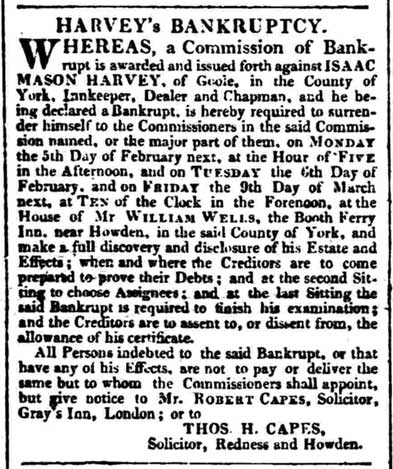
A further advert from July 1827 shows The Banks' Arms
for rent, described as a newly erected inn with 50 acres of land.
Prospective tenants were advised to apply to Woodhead and Hurst
of Doncaster, the architects. John Linn would show the premises.
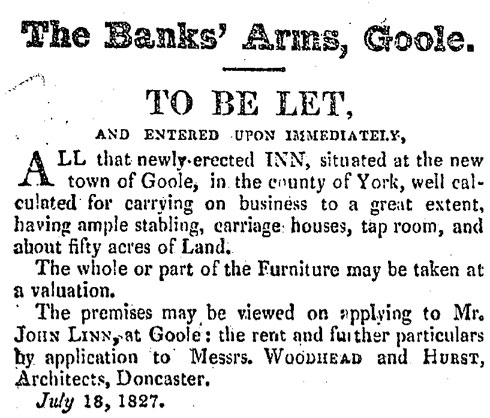
By 1828 the Aire & Calder Navigation had bought the hotel and the Banks' Arms Hotel was again offered for rent. In June 1828 a sale of the contents owned by the previous landlord, Mr Linn, was held (see below article from the Hull Advertiser). These were probably the original furnishings dating from the hotel's opening.
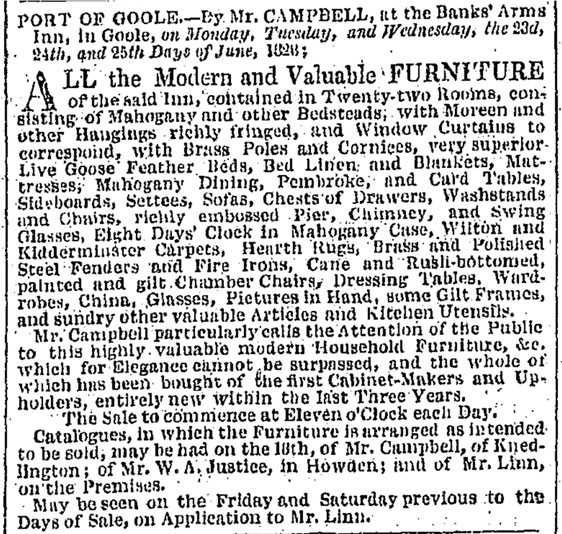
The new landlord in 1828 was Thomas Robinson, as the following newspaper advert from October 1828 shows. This small engraving of the hotel is most probably the earliest image of the building in existence.
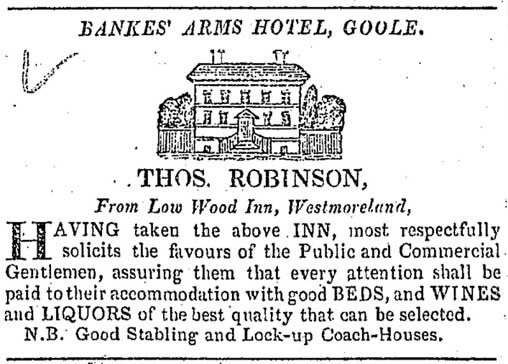
At some point soon after this, the property seems to have been divided into two business premises. There was a 'commercial' inn run in 1834 by Robert Chattam with an Aire Street address and also The Banks' Arms Hotel, William Airton, with a Banks' Terrace address. Robert Chattam also acted as the town auctioneer.
Sir Edward Banks died in 1835 and, sometime between 1838 and 1851, the name of the hotel was changed to the Lowther Hotel in honour of Sir John Lowther, who was the chairman of the Aire & Calder Navigation when the canal was first opened.
In subsequent records the Lowther was sometimes known as the Lowther Arms rather than the Lowther Hotel.
The Lowther & the early town of Goole
The hotel itself was originally built in a square with service quarters, stores, stables and coach houses around a courtyard. Now only the hotel and the northern wing remain. The rooms on the first floor (banqueting, dining and board) were used by the A&CN for meetings and many other purposes.
The Lowther was, for many years, the building where most major events in the town's history took place. For example, the first meetings of the Congregationalists took place there; a preacher, Rev. Henry Earl, was engaged on the 28th December 1828 and he began preaching in a hired room belonging to the Lowther. He soon began a Sunday school there too. However, the room became too small and a group of worshippers leased a plot of land a few yards from the Lowther from the A&CN. On this plot they built the first Independent chapel in Goole, and the street on which it stood later became Chapel Street.
Similarly, the Primitive Methodists also used the Lowther and held their meetings in a granary in the Lowther yard in the 1820s and '30s. One story told of these days was that, one evening, the singing and praying was so loud that neighbours went in search of Goole’s only constable. Unable to find him, the neighbours peered into the granary, only to find the constable taking part in the proceedings!
Reverend John Wilson, the first Church of England minister (1831-37) in Goole held a school, for boys and girls, in a room in the Lowther Hotel yard, which was over the old billiard room. This room was later converted into a dwelling for the ostler.
The Lowther Murals
Upstairs on the first floor of the Lowther was the room used as the A&CN board room when meetings were held in Goole. It is beautifully decorated with wall paintings, some featuring what is believed to be the silhouette of George IV and Georgian swags, but the most interesting of all being those which feature various views of Goole docks. These have recently been restored and additional details revealed, which had previously been hidden beneath wallpaper and heating pipes.
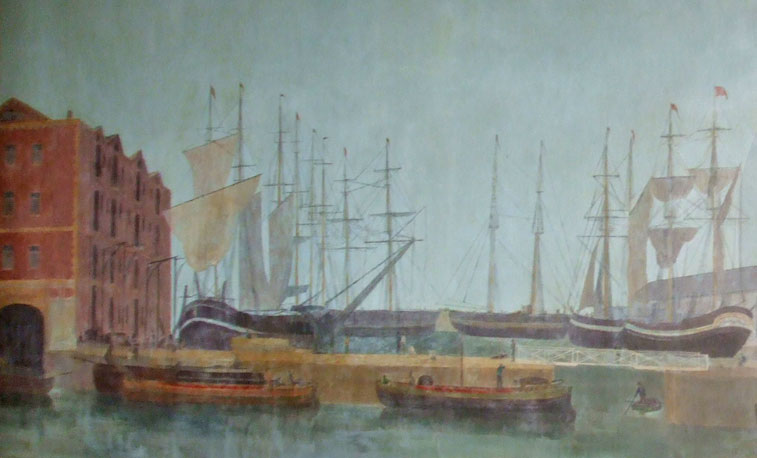
Detail from one of the Lowther murals
No-one is yet sure when exactly the murals were painted or by whom.
It is likely, however, that they were already in place by 1835,
as one mural depicts the dock gates which were destroyed by severe
flooding in November 1835 and never replaced.
There is potentially some evidence from the Goole Customs records of 1834, which are said to include an entry for a payment from Richard Clay, shipping agent for the A&CN, to a Mr Bromley, who had painted the murals.
However, even if this is accurate, there were, in this period, several members of the Bromley family to whom it may apply. They were a large family involved in many aspects of the town's life.
They owned their own vessels and several members of the family were in business as ship's chandlers, supplying necessities to the shipping trade. There are some original letters written by the Bromley brothers in the Goole museum.
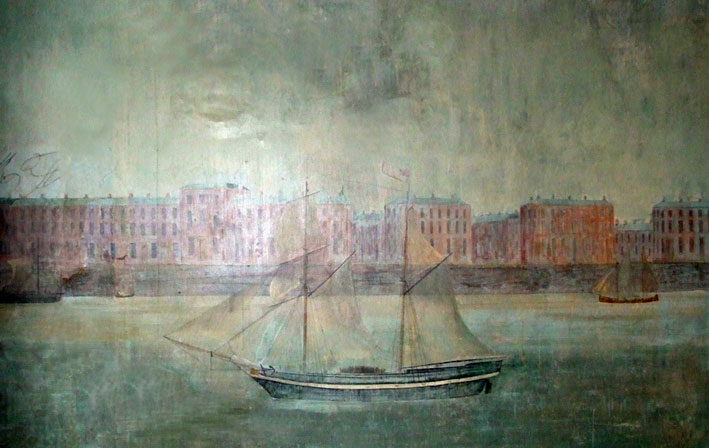
Further detail from the Lowther murals
Richard Bromley was a captain and then by 1841 a ship's chandler,
as eventually were his brothers Robert and John Bromley. Thomas
Bromley was a wine and spirit merchant in 1851 (his premises were
later the Royal Hotel). Perhaps the best candidate as the artist
is their brother James Bromley, who was a packet proprietor in 1841,
but by 1851 had moved to London where he was the manager of a diorama
in St Marylebone.
Dioramas were a popular form of entertainment in Victorian London. The diorama was a theatrical experience viewed by an audience in a highly specialized theatre. As many as 350 patrons would file in to view a landscape painting that would change its appearance both subtly and dramatically. Most would stand, though limited seating was provided. The show lasted 10 to 15 minutes, after which time the entire audience (on a massive turntable) would rotate to view a second painting.
This line of work seems to point to James having an artistic leaning - did he paint the landcapes in the London diorama? However, perhaps the work did not support a family; by 1861 he was described as a London accountant.
Landlords of the Lowther
William Airton remained as landlord of The Banks' Arms Hotel (later renamed as the Lowther) until he sold up in March 1838. He died in 1840 but his son William Henry stayed in the town and was a wine merchant, firstly on East Parade and then on North Street.ed3
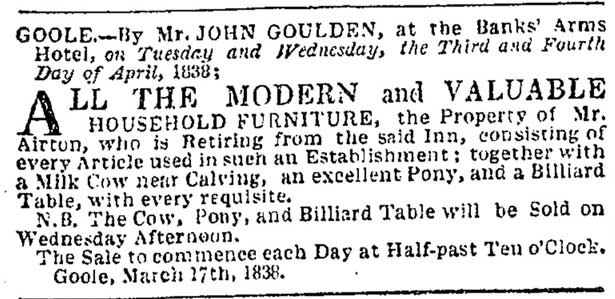
Sale of contents of The Banks' Arms, Goole, in April 1838
It is difficult after this to keep track of who was landlord of
which inn in Goole, as there seems to have been a sort of 'musical
chairs' process going on.
Robert Chattam took over at the 'main' Lowther Hotel in 1838 and was still there in 1841, but ten years later he was landlord at the Sydney, which was then probably quite new.
In 1849 Joseph Rodgers was at the Lowther Hotel, Robert Chattam was still at the Sydney, and Joseph Byron Cliffe was at the McIntosh Arms, also on Aire Street.
However, by 1851 the innkeeper at the Lowther Hotel was Joseph Cliffe, who was then 36 and from Knottingley; his wife Eliza was from Herefordshire. The Lowther Hotel tap in Adam Street was run by William Williamson, 'tapster and coal porter'.
But by the 26th August 1857 Robert Chattam was back at the Lowther Hotel. Only a year later he was gone again, and the new landlord was William Lawson. William Lawson was in trouble just a few weeks later in December 1858, when he was summonsed for permitting shouting and fighting at his premises, to the disturbance of the neighbourhood.
Robert Chattam, described as 'late of the Crown Hotel, Rotherham, and the Lowther Hotel, Goole', died in February 1873 at the Ram Hotel, Newark, aged 76.
Reading the Riot Act
By 1861 the Hawke family had moved into the Lowther from Howden. Charles, who was a painter by trade, was the licensee, but died in 1864; his son William had taken over by 1871. He was married to Isabella and had two children, Charles and William. Isabella died in 1879 and William remarried to Lucy Heslop the same year.
William was the landlord when in 1880 there was a disturbance on election day and the Riot Act was read to the crowd below by Mr Bladworth, the magistrate, who was standing on the top of the portico at the front of the Lowther. The Conservative party was using the Lowther as their headquarters and fights broke out as their opponents, supporters of the Liberals, surrounded the hotel and tried to get in. These were heated times as many people supported the land reforms of the Irishman Charles Parnell and wore orange 'favours'. It was said that every window in the Lowther was smashed. Police reinforcements were drafted in, although matters were calmer by the time they arrived and the locals apparently had to rescue one policeman from a dock, as these newcomers were not familiar with the sudden drops into the water from the dock walls!
Mrs Emily Gelder, who would have been about 13 at the time, remembered "the riot on election day. I remember seeing all the windows broken at the Lowther Hotel. I can just picture seeing Mr Henry Wilson senior with his top hat knocked in and blood streaming down his face."
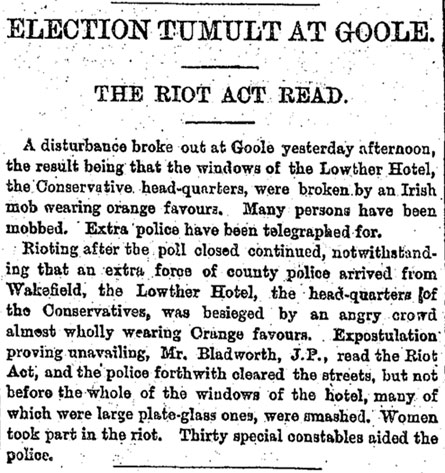
In 1881 the Lowther was very well staffed with eight live in workers. There was a cook, two housemaids, a kitchen maid, a waiter, a billiard marker, a 'boots' and a nurse.
In the Lowther yard there was the premises previously run as a school by Rev. John Wilson and now occupied by an ostler (John Hill from Epworth), his wife, his daughter, and his son in law (George Mobbs, a coal merchant’s clerk).
William Hawke died in 1888.
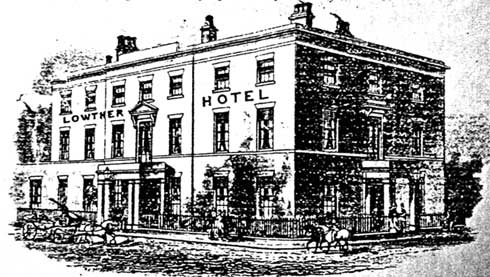
The Lowther as it would have appeared when William Hawke was landlord; taken from a billhead dated 1880.
By the 1890s the landlord was Joseph Cawthorn. His family consisted of his wife Annie Raywood and their sons Mark (the hotel manager), Lionel (a chemist's apprentice) and Arthur (a postal service worker).
The landlord in 1911 was Louis Chatterton from Kent. He was aged 55 and had a wife Carrie, aged 27, and a daughter Louise, aged 2. They had five servants - a female servant, cook, barman, waitress and a chambermaid.
The landlord by 1913 was T C Davison, who was there in 1915 when again every window in the Lowther was broken. This was as a result of a Zeppelin raid on Goole on August 9th 1915. Next morning an eye witness reported,
“When
we reached Aire Street we had to walk in the middle of the road
as every shop window was broken into fragments on the pavements.
We came to the Lowther Hotel and all the windows were blown in as
a bomb had fallen on the railway wagon just opposite. It was of
course blown to pieces. We went down Ouse Street where all the windows
were all blown out and in George Street was a house with all the
back blown [down] and a pile of bricks.”
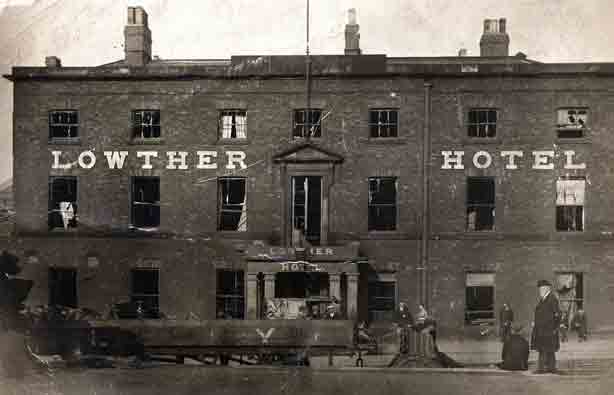
The Lowther, pictured the morning after the Zeppelin raid of August 1915
Later landlords were William Coward, followed by H C Birch.
In 1934 Edgar Hall arrived at the Lowther. A native of Burnley, he came to Goole to manage the billiard hall. When he died in 1944 his wife Mary, originally from Edinburgh, carried on as landlady. She was a very well-known personality in the town. She was helped by Mrs Dot Kaye. Mrs Hall retired on July 4th 1962, as did Mrs Kaye.
The Lowther Cannon
Part of the folklore of Goole is the mystery of the Lowther cannon. This stood for many years on top of the portico at the front of the hotel. It was said to be a cannon from one of Sir Edward Banks' vessels and was originally used on the quayside to salute the opening of the new port.
The cannon mysteriously disappeared in 1969 and the rumours of whodunnit are legion. A replica now stands in its place.
If you would like to add any information to this article, I
would be delighted if you would get in contact. We are especially
keen to include any further memories or material related to the
Lowther's history.
